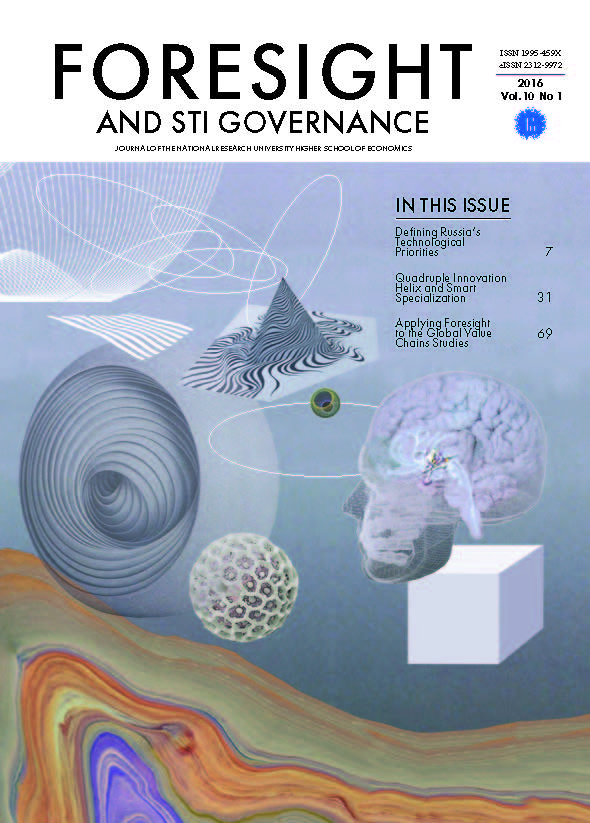Abstract
The article examines Russia’s dependence on high-tech imported goods. We improve the OECD high-technology product classification by increasing the level of disaggregation, accounting for new goods, ensuring comparability over time, and differentiating goods by technological level on quite high levels of disaggregation. We describe the major trends in the world market for high-tech goods and identify the leading countries in each sector (most frequently, China, Germany, Republic of Korea, Switzerland, and Singapore) primarily by calculating net exports of high-tech goods in these sectors. We also assess Russian competitive positions in the global market for high-tech goods by sectors, applying the newly developed competitiveness index, and measure Russian dependence on high-tech goods imported from countries that recently imposed sanctions against Russia. We show that Russia’s economy is highly dependent on imports of pharmaceutical goods and medical equipment, machinery and equipment (except nuclear reactors, fuel elements, engines and turbines), and electrical equipment. The sectors with most imports originating from ‘sanction-imposing’ countries are aircraft, medical and optical equipment, engines and turbines, and pharmaceutical goods. Computers and electronic equipment are at the opposite pole: in these sectors, China is the world leader and the key partner for Russia.References
Balassa B. (1965) Trade Liberalization and Revealed Comparative Advantage // Manchester School of Economic and Social Studies. Vol. 33. № 2. Р. 99-123.
Bas M., Berthou A. (2012) The Decision to Import Capital Goods in India: Firms' Financial Factors Matter // World Bank Economic Review. Vol. 26. № 3. Р. 486-513.
Bas M., Strauss-Kahn V. (2014) Does Importing More Inputs Raise Exports? Firm-Level Evidence from France // Review of World Economics. Vol. 150. № 2. Р. 241-275.
Caselli F., Wilson D. (2004) Importing Technology // Journal of Monetary Economics. Vol. 51. № 1. Р. 1-32.
Coe D., Helpman E. (1995) International R&D Spillovers // European Economic Review. № 39. Р. 859-887.
Colantone I., Crino R. (2014) New Imported Inputs, New Domestic Products // Journal of International Economics. Vol. 92. № 1. P. 147-165.
Eurostat (2015a) Eurostat indicators on High-tech industry and Knowledge-intensive services. Annex 5 - High-tech aggregation by SITC Rev. 4. Luxembourg: Eurostat. Режим доступа: http://ec.europa.eu/eurostat/cache/metadata/Annexes/htec_esms_an5.pdf, дата обращения 15.09.2015.
Eurostat (2015b) LALL’s technological classification of export. Luxembourg: Eurostat. Режим доступа: http://ec.europa.eu/eurostat/ramon/documents/lall/LALL_SITC_Rev_3.zip, дата обращения 15.09.2015.
Feng L., Li Z., Swenson D. (2012) The Connection between Imported Intermediate Inputs and Exports: Evidence from Chinese Firms. NBER Working Paper № 18260. Cambridge, MA: National Bureau of Economic Research.
Gnidchenko A., Salnikov V. (2015) Net Comparative Advantage Index: Overcoming the Drawbacks of the Existing Indices. NRU HSE Basic Research Program Working Paper WP BRP 119/EC/2015. Moscow: National Research University Higher School of Economics.
Griliches Z. (1973) Research Expenditures and Growth Accounting // Science and Technology in Economic Growth / Ed. B. Williams. New York: John Wiley & Sons, Halsted Press. P. 59-95.
Griliches Z., Lichtenberg F. (1984) Interindustry Technology Flows and Productivity Growth: A Reexamination // Review of Economics and Statistics. Vol. 66. № 2. Р. 324-329.
Hatzichronoglou T. (1997) Revision of the High-Technology Sector and Product Classification. OECD Science, Technology and Industry Working Paper № 1997/02. Paris: OECD.
Keller W. (2000) Do Trade Patterns and Technology Flows Affect Productivity Growth? // World Bank Economic Review. Vol. 14. № 1. Р. 17-47.
Krammer S. (2014) Assessing the Relative Importance of Multiple Channels for Embodied and Disembodied Technological Spillovers // Technological Forecasting and Social Change. Vol. 81. Р. 272-286.
Lall S. (2000) The Technological Structure and Performance of Developing Country Manufactured Exports, 1985-1998. University of Oxford QEH Working Paper № 44. Oxford: University of Oxford.
Lichtenberg F., van Pottelsberghe de la Potterie B. (1998) International R&D Spillovers: A Re-Examination. NBER Working Paper № 5668. Cambridge, MA: National Bureau of Economic Research.
OECD (2011) ISIC rev. 3. Technology intensity definition. Classification of manufacturing industries into categories based on R&D intensities. Paris: OECD. Режим доступа: http://www.oecd.org/sti/ind/48350231.pdf, дата обращения 12.09.2015.
Papaconstantinou G., Sakurai N., Wyckoff A. (1996) Embodied Technology Diffusion: An Empirical Analysis for 10 OECD Countries. OECD Science, Technology and Industry Working Paper No. 1996/01. Paris: OECD.
Scherer F. (1982) Inter-Industry Technology Flows and Productivity Growth // Review of Economics and Statistics. Vol. 64. № 4. Р. 627-634.
Stone S., Shepherd B. (2011) Dynamic Gains from Trade: The Role of Intermediate Inputs and Equipment Inputs. OECD Trade Policy Paper № 110. Paris: OECD.
Terleckyj N. (1974) Effects of R&D on the Productivity Growth of Industries: An Exploratory Study. Washington, D.C.: National Planning Association.
Terleckyj N. (1980) Direct and Indirect Effects of Industrial Research and Development on the Productivity Growth of Industries // New Developments in Productivity Measurement / Eds. J. Kendrick, B. Vaccara. Chicago: University of Chicago Press. P. 357-386.
Trilateral Patent Offices (2007) Trilateral Statistical Report. 2007 Edition. Munich: European Patent Office, Japan Patent Office, United States Patent and Trademark Office. Режим доступа: http://www.trilateral.net/statistics/tsr/2007/TSR.pdf, дата обращения 21.09.2015.
UNIDO (1982) Changing Patterns of Trade in World Industry: An Empirical Study on Revealed Comparative Advantage. New York: United Nations.
Wolff E., Nadiri I. (1993) Spillover Effects, Linkage Structure, and Research and Development // Structural Change and Economic Dynamics. Vol. 4. № 2. P. 315-331.
Xu B., Wang J. (1999) Capital Goods Trade and R&D Spillovers in the OECD // Canadian Journal of Economics. Vol. 32. P. 1258-1274.
Zhu L., Jeon B. (2007) International R&D Spillovers: Trade, FDI, and Information Technology as Spillover Channels // Review of International Economics. Vol. 15. № 5. Р. 955-976.
Гнидченко А., Сальников В. (2014) Ценовая конкурентоспособность российской внешней торговли // Вопросы экономики. № 1. С. 108-129.

This work is licensed under a Creative Commons Attribution 4.0 International License.

